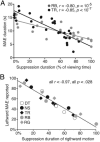Strength of early visual adaptation depends on visual awareness
- PMID: 16537384
- PMCID: PMC1400587
- DOI: 10.1073/pnas.0509634103
Strength of early visual adaptation depends on visual awareness
Abstract
We measured visual-adaptation strength under variations in visual awareness by manipulating phenomenal invisibility of adapting stimuli using binocular rivalry and visual crowding. Results showed that the threshold-elevation aftereffect and the translational motion aftereffect were reduced substantially during binocular rivalry and crowding. Importantly, aftereffect reduction was correlated with the proportion of time that the adapting stimulus was removed from visual awareness. These findings indicate that the neural events that underlie both rivalry and crowding are inaugurated at an early stage of visual processing, because both the threshold-elevation aftereffect and translational motion aftereffect arise, at least in part, from adaptation at the earliest stages of cortical processing. Also, our findings make it necessary to reinterpret previous studies whose results were construed as psychophysical evidence against the direct role of neurons in the primary visual cortex in visual awareness.
Conflict of interest statement
Conflict of interest statement: No conflicts declared.
Figures





References
-
- Frisby J. Seeing: Illusion, Brain and Mind. Oxford: Oxford Univ. Press; 1979.
-
- Kim C.-Y., Blake R. Trends Cognit. Sci. 2005;9:381–388. - PubMed
-
- Blake R., Fox R. Nature. 1974;249:488–490. - PubMed
-
- Lehmkuhle S. W., Fox R. Vision Res. 1975;15:855–859. - PubMed
-
- O’Shea R. P., Crassini B. Vision Res. 1981;21:801–804. - PubMed
Publication types
MeSH terms
Grants and funding
LinkOut - more resources
Full Text Sources

